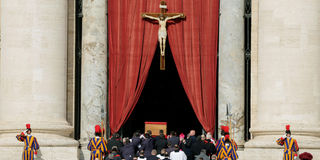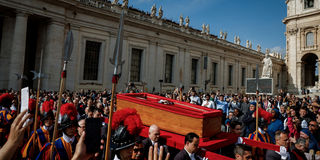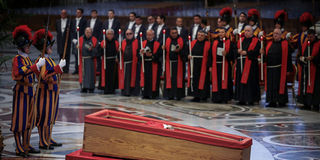
Pope Francis swings a thurible of incense during an ordination mass on April 25, 2021 at St. Peter's Basilica in The Vatican, during which he is to ordain nine priests for his diocese as bishop of Rome.
After three days of lying in state, Pope Francis’s open coffin was publicly sealed yesterday evening ahead of today’s burial.
The sealing was after a mass led by Kevin Joseph Farrell, the Carmelengo – interim administrative leader of the Catholic Church.
It began at 8pm Italian time (9pm in Kenya) after tens of thousands had filed past the body.
By Friday morning, Vatican News reported, more than 125,000 people had gone to the Basilica to honour Pope Francis.
Viewing yesterday started at 5.40am, an hour and 20 minutes ahead of the scheduled time. The Vatican press said this was to “accommodate the crowds of mourners”. The viewing had been extended from 12am to 2.30am on Thursday.
Before the sealing of the coffin, Pope Francis’s face was covered in a white cloth, marking the last time he would be seen by any mortal.

The coffin containing the body of the late Pope Francis is carried to St. Peter's Basilica during a procession, on the day of the translation of his body, at the Vatican, April 23, 2025.
Twelve golden coins, each representing every year he served as Pope, were placed in the casket. The church tradition is that every year served as Pope is represented by a gold coin; every month by a silver coin and every day on top by a bronze one.
Also included in the casket was a sealed tube containing a piece of paper with highlights of his life as Pope. The paper was read before being folded and placed in its position.
Afterwards, the coffin was sealed in stages that included soldering the metallic part and using golden nails to shut the outermost part.
Pope Francis will be buried about six kilometres away from where his predecessor, Benedict XVI and most other popes have been interred.
He chose the site, seeking to have his body buried at a church he loved and breaking from tradition. In fact, Pope Francis had to amend a church document on the burial of pontiffs last year to provide for burial at a place other than St Peter’s Basilica, where at the remains of about 90 popes are buried.
Italian immigrants
“He will be the first pontiff in more than a century to be buried outside the Vatican,” the CNN said yesterday, adding that the last time that happened was with Pope Leo XIII, who died in 1903.
From as far back as 2022, Pope Francis had chosen the ancient church – which was commissioned in 431 – as his burial ground.

Pope Francis' body is carried in a coffin into Saint Peter's Basilica at the Vatican on the day of its translation, at the Vatican, April 23, 2025.
“As I sense that the twilight of my earthly life is approaching, I wish that my final earthly journey concludes precisely in this ancient Marian shrine, where I go to pray at the beginning and end of every apostolic journey to faithfully entrust my intentions to the Immaculate Mother,” Pope Francis wrote in a June 29, 2022 testament that was published by the Vatican after his death on Monday.
Due to the distance from the site of the service (St Peter’s Basilica) and where the burial will take place (Basilica di Santa Maria Maggiore), the burial will also feature a rarity in papal burials — a procession.
At his chosen site, seven other Popes are buried there. According to the Catholic News Agency, the other popes at the site are Honorius III, Nicholas IV, St Pius V, Sixtus V, Paul V, Clement VIII and Clement IX.
The Basilica di Santa Maria Maggiore, CNN added, is perched on one of the seven hills on which ancient Rome was built.

Members of the Swiss Guard stand next to the coffin containing Pope Francis' body, on the day of the translation of his body, in St. Peter's Basilica at the Vatican, April 23, 2025.
“It is one of four papal basilicas. Its bell tower is the tallest in the Italian capital, rising to 246 feet, and its position on the hill makes it the highest point in the city,” CNN reported.
Pope Francis’s tomb will also feature another item of his wishes – the marble that will make it.
As reported by Vatican News, Pope Francis had directed that his tomb be made from materials from the Italian region of Liguria.
“It is a simple tomb bearing only the inscription ‘Franciscus’ and a reproduction of the Pope’s pectoral cross,” the outlet reported.
“Pope Francis often kept his connection to Liguria private, so the Mayor of the town, Enrica Sommariva, described her surprise when she heard that the Pope had requested stone from his grandparents’ region for his tomb.”
Pope Francis was born in Argentina in 1936 to parents who had migrated from Italy.
Vatican News quoted an official who described the material recommended by Pope Francis as “not a noble stone” but “the people’s stone”.
This is in line with Pope Francis’s wish to illustrate that a “pontiff’s funeral is that of a pastor and disciple of Christ and not of a powerful man of this world” as explained to the press by the Vatican’s master of liturgical ceremonies, Archbishop Diego Ravelli.
In his 2022 document, Pope Francis had specified that his tomb “should be in the ground; simple, without particular ornamentation and bearing only the inscription: ‘Franciscus’”.
Today’s mass, which begins at 10am (11am Kenyan time) will mark the start of nine days of mourning where a mass will be held every day. The church calls them nine days in suffrage.
Sunday will be the second day in which mass will be held at 10.30am. From Monday through the ninth day, the mass will be held at St Peter’s Basilica at 5pm.
“Following an ancient tradition, the Catholic Church will observe nine consecutive days of mourning, marked by masses held in suffrage for Pope Francis,” the Vatican News wrote on Thursday.
Presiding over these masses will be various cardinals of the church.

Nuns attend prayers for late Pope Francis ahead of his funeral, at the Shrine of our Lady of Lebanon in Harissa village, north of Beirut, Lebanon, April 25, 2025.
Speaking of Cardinals, the Pope’s representative in Kenya, Archbishop Hubertus Matheus Maria van Megen, said Kenya’s third archbishop may come during the reign of the next Pope.
In an interview on Citizen TV on Thursday night, Archbishop Megen – whose role is officially called apostolic nuncio – said that as much as he plays a role in the selection of bishops – by vetting them and presenting names to the Vatican – he has no part in the appointment of a cardinal.
“Even to a nuncio, up to a certain extent, it is a mystery because we are not involved. I have no clue how that works, and in many ways it is through direct lines. What happened, for example with Pope Francis, was sometimes a bishop would go to Rome innocently. He might have an appointment with the Holy Father on some issues, he leaves and the Holy Father, so fascinated by the bishop, sees many qualities in him, says, ‘Okay, that guy is going to be a cardinal,’” Archbishop Metheus said.
“It is a privilege prerogative of the Holy Father to appoint that directly.”
He added that he is in favour of a new cardinal in Kenya.
“I could mention two or three names, which of course I’m not going to do, but we hope with a new Pope, we will get there,” he said.

A nun reacts as she pays respects to Pope Francis inside St. Peter's Basilica, as Pope Francis lies in state, at the Vatican, April 25, 2025.
Kenya has not had a cardinal since John Cardinal Njue left the position in 2021.
He was the country’s second cardinal after Maurice Cardinal Otunga, who died in 2003.
Media sources say there are 135 cardinals eligible to vote – 108 of whom were appointed by Pope Francis.
They will gather in a conclave in the Vatican in the coming days to elect the next Pope through secret ballot.
Whoever garners two-thirds of the vote will become the successor of Pope Francis.
eondieki@ke.nationmedia.com







